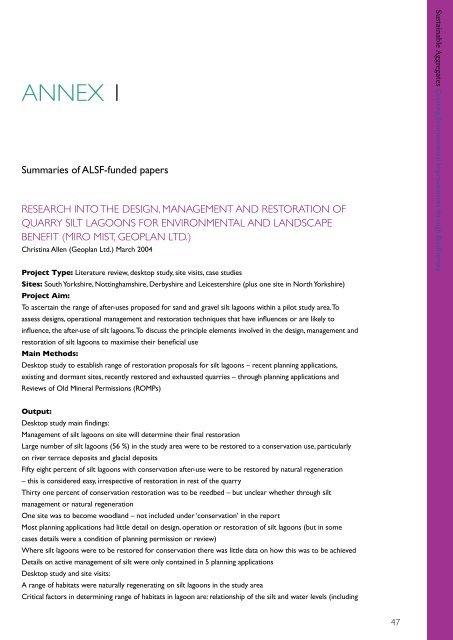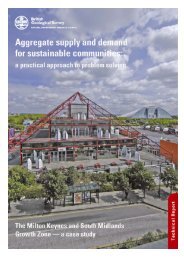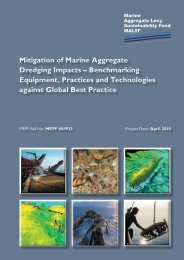creating environmental improvements through biodiversity
creating environmental improvements through biodiversity
creating environmental improvements through biodiversity
Create successful ePaper yourself
Turn your PDF publications into a flip-book with our unique Google optimized e-Paper software.
ANNEX 1<br />
Summaries of ALSF-funded papers<br />
RESEARCH INTO THE DESIGN, MANAGEMENT AND RESTORATION OF<br />
QUARRY SILT LAGOONS FOR ENVIRONMENTAL AND LANDSCAPE<br />
BENEFIT (MIRO MIST, GEOPLAN LTD.)<br />
Christina Allen (Geoplan Ltd.) March 2004<br />
Project Type: Literature review, desktop study, site visits, case studies<br />
Sites: South Yorkshire, Nottinghamshire, Derbyshire and Leicestershire (plus one site in North Yorkshire)<br />
Project Aim:<br />
To ascertain the range of after-uses proposed for sand and gravel silt lagoons within a pilot study area. To<br />
assess designs, operational management and restoration techniques that have influences or are likely to<br />
influence, the after-use of silt lagoons. To discuss the principle elements involved in the design, management and<br />
restoration of silt lagoons to maximise their beneficial use<br />
Main Methods:<br />
Desktop study to establish range of restoration proposals for silt lagoons – recent planning applications,<br />
existing and dormant sites, recently restored and exhausted quarries – <strong>through</strong> planning applications and<br />
Reviews of Old Mineral Permissions (ROMPs)<br />
Sustainable Aggregates Creating Environmental Improvements <strong>through</strong> Biodiversity<br />
Output:<br />
Desktop study main findings:<br />
Management of silt lagoons on site will determine their final restoration<br />
Large number of silt lagoons (56 %) in the study area were to be restored to a conservation use, particularly<br />
on river terrace deposits and glacial deposits<br />
Fifty eight percent of silt lagoons with conservation after-use were to be restored by natural regeneration<br />
– this is considered easy, irrespective of restoration in rest of the quarry<br />
Thirty one percent of conservation restoration was to be reedbed – but unclear whether <strong>through</strong> silt<br />
management or natural regeneration<br />
One site was to become woodland – not included under ‘conservation’ in the report<br />
Most planning applications had little detail on design, operation or restoration of silt lagoons (but in some<br />
cases details were a condition of planning permission or review)<br />
Where silt lagoons were to be restored for conservation there was little data on how this was to be achieved<br />
Details on active management of silt were only contained in 5 planning applications<br />
Desktop study and site visits:<br />
A range of habitats were naturally regenerating on silt lagoons in the study area<br />
Critical factors in determining range of habitats in lagoon are: relationship of the silt and water levels (including<br />
47

















